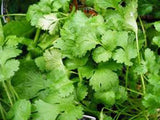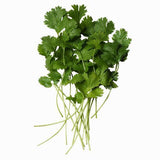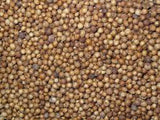COUNTRY CREEK LLC
Cilantro Seeds

Description, Nutritional Value
Cilantro is a fragrant herb commonly used in Central American, Middle Eastern, and Asian cuisines. In the United States, cilantro refers to the leaves and stems of the Coriandrum sativum plant, while the seeds are called coriander. In many cultures, the word coriander can refer to any part of the plant. Although slightly resembling flat leaf parsley in appearance, cilantro can be distinguished by its unmistakable aroma and flavor. Cilantro offers citrus overtones with a flavor that can be bright, earthy and pungent, though its pungency is often contested to border on "soapiness". If left to go to seed, the plant produces white delicate flowers from the cilantro leaves that have the exact essence of cilantro with a sweet floral finish.
Cilantro is a good source of Vitamins A and K, dietary fiber, and manganese. The entire Cilantro plant – roots, stems, and leaves are all edible, boasting different beneficial nutrients. Essential oils that are distilled from the Cilantro plant have been said to aid in digestion used to sooth irritated skin.
How To Grow At Home
The Slow Bolt Cilantro is an easy to grow variety that has a great flavor! This variety gets its name for being slow to bolt; bolting means that the plant starts to produce the seed, rather than growing more leaves.
*
Choose The Time of Year: The best time to plant cilantro depends on where you live. Cilantro won't survive in frosty conditions, but it doesn't like extreme heat either. In temperate climates, the best time to start planting cilantro is in late spring, between the months of March and May (Northern Hemisphere). In more tropical climates, cilantro will grow better during cooler, dry times of year, such as fall.
* Prepare A Spot In Your Garden: Select a patch of soil where the cilantro will get full exposure to the sun. It will tolerate some shade in southerly areas where the sun gets very hot during the day. The soil should be light and well-drained with a pH of 6.2 to 6.8.
* Plant The Cilantro Seeds: Sow the seeds about 1⁄4 inch (0.6 cm) deep, spaced 6 to 8 inches (15.2 to 20.3 cm) apart, in rows approximately 1 foot (0.3 m) apart. Cilantro seeds need plenty of moisture to germinate, so make sure to water them frequently. They need about an inch of water per week. They should germinate in about 2 to 3 weeks.
* Care For The Cilantro: Once the seedlings have reached about 2 inches (5.1 cm) in height, you can fertilize them with compost or organic fertilizer. Be careful not to over-fertilize, you only need about 1/4 of a cup for every 25 feet (7.6 m) of growing space.

How To Serve
A good cilantro lime rice recipe is one of those dishes everyone should have in their cooking arsenal because it is endlessly useful. It can be used as a filling in burritos, a base to build rice bowls, or serve it as a side to complete a meal! It’s filling, delicious, and has just the right balance of cilantro and bright tangy lime flavor so you’ll want to serve it with everything.
Long-grain rice: I prefer long-grain rice like basmati or jasmine rice for cilantro rice because it cooks up fluffy and not too sticky. You can use almost any rice, but you might need to adjust the cooking time and amount of liquid in the recipe.
Butter: Adding just a bit of fat to the rice gives it a little extra flavor and richness.
Lime juice and zest: We’ll use both the zest and the juice from one lime for this recipe. For the easiest zesting, zest the lime first using a microplane and then slice it open and juice it.
Chicken broth: Replacing the water in the rice with chicken broth adds a ton of flavor.
Cilantro: When measuring cilantro for the recipe, very loosely pile it into your measuring cup. Don’t pack it in tightly or you’ll end up with a LOT of cilantro in your rice.


Origin
All Seeds are grown and packaged in the U.S. (Each bag is individually labeled)

Germination
All seeds lots are tested for germination.

Sprouter
These seeds work great with any type of sprouter!







